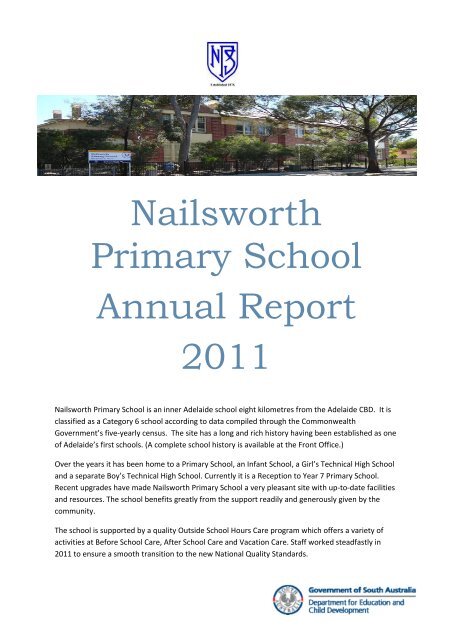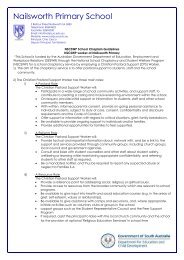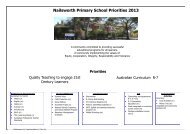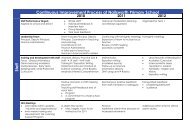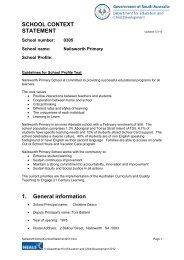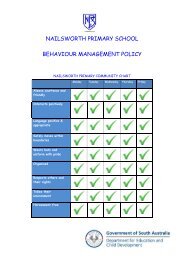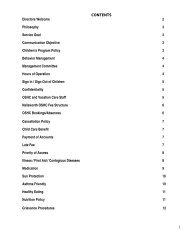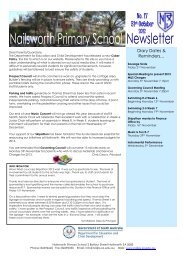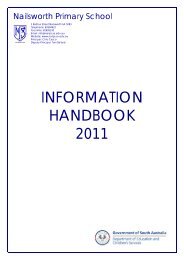Annual Report - Nailsworth Primary School
Annual Report - Nailsworth Primary School
Annual Report - Nailsworth Primary School
Create successful ePaper yourself
Turn your PDF publications into a flip-book with our unique Google optimized e-Paper software.
<strong>Nailsworth</strong><br />
<strong>Primary</strong> <strong>School</strong><br />
<strong>Annual</strong> <strong>Report</strong><br />
2011<br />
<strong>Nailsworth</strong> <strong>Primary</strong> <strong>School</strong> is an inner Adelaide school eight kilometres from the Adelaide CBD. It is<br />
classified as a Category 6 school according to data compiled through the Commonwealth<br />
Government’s five‐yearly census. The site has a long and rich history having been established as one<br />
of Adelaide’s first schools. (A complete school history is available at the Front Office.)<br />
Over the years it has been home to a <strong>Primary</strong> <strong>School</strong>, an Infant <strong>School</strong>, a Girl’s Technical High <strong>School</strong><br />
and a separate Boy’s Technical High <strong>School</strong>. Currently it is a Reception to Year 7 <strong>Primary</strong> <strong>School</strong>.<br />
Recent upgrades have made <strong>Nailsworth</strong> <strong>Primary</strong> <strong>School</strong> a very pleasant site with up‐to‐date facilities<br />
and resources. The school benefits greatly from the support readily and generously given by the<br />
community.<br />
The school is supported by a quality Outside <strong>School</strong> Hours Care program which offers a variety of<br />
activities at Before <strong>School</strong> Care, After <strong>School</strong> Care and Vacation Care. Staff worked steadfastly in<br />
2011 to ensure a smooth transition to the new National Quality Standards.
<strong>Nailsworth</strong> <strong>Primary</strong> <strong>School</strong> <strong>Annual</strong> <strong>Report</strong> 2011<br />
Many special programs and occasions are organised to engage students in their learning.<br />
Page 2
<strong>Nailsworth</strong> <strong>Primary</strong> <strong>School</strong> <strong>Annual</strong> <strong>Report</strong> 2011<br />
Context<br />
<strong>School</strong> Name: <strong>Nailsworth</strong> <strong>Primary</strong> <strong>School</strong> <strong>School</strong> Number: 0305<br />
Principal: Christine Cesco Region: Eastern Adelaide<br />
<strong>Nailsworth</strong> <strong>Primary</strong> <strong>School</strong> completed 2011 with 524 students. 41% of students were from a Non‐English Speaking<br />
Background, 15% of students qualified for <strong>School</strong> Card financial assistance, 0.08% of students are of Aboriginal or<br />
Torres Strait Island heritage. 5% of students are recognised as students with a learning disability.<br />
The school population has grown over recent years with the most noticeable growth being in the Junior <strong>Primary</strong><br />
section of the school. We completed 2011 with 20 classes. Classes at NPS were formed to provide the best<br />
learning situation for students. When classes are formed, gender, learning needs and friendship groupings are<br />
considered.<br />
As a result of these additional enrolments, we have received a funding increase which has been used to provide<br />
extensive learning support programs for students. The school has both learning support and extended<br />
methodology programs which assist identified students.<br />
A social skills program was run for groups of students.<br />
The school had an active Student Representative Council comprising elected students from Years 3‐7. Students<br />
held office for 2 terms. A policy was in place to ensure a broad selection of students had the opportunity to<br />
nominate as SRC representatives. These representatives worked with buddy classes from the younger grades. SRC<br />
had 2 representatives on Governing Council. The SRC ensures that classes take on school responsibilities hence<br />
further supporting our school belief in individuals developing a sound sense of responsibility.<br />
NPS prides itself on offering a safe, supportive environment where learners are able to access many and varied<br />
opportunities in order to develop to their full potential. NPS students are guided to be successful, responsible and<br />
collaborative learners.<br />
In 2011 Program Achieve was promoted at all year levels. Students were taught within the guidelines of getting<br />
along, being responsible, being organised, being resilient and being confident. The school used an agreed<br />
continuum of thinking skills over the year levels to develop student learning.<br />
The NPS community inclusive of staff, students and parents continued to work together for the benefit of all<br />
students.<br />
Critical thinking, participation, different learning styles and rates of learning, the uniqueness of the individual<br />
and learning to learn are highly valued.<br />
Page 3
<strong>Nailsworth</strong> <strong>Primary</strong> <strong>School</strong> <strong>Annual</strong> <strong>Report</strong> 2011<br />
2011 Highlights<br />
Highlights of the year were the number and variety of programs offered to students to help them effectively<br />
engage in their learning in all areas of their development.<br />
The staff while preparing for the introduction of the National Curriculum, have presented a State Curriculum<br />
comprising English, Mathematics, Science, Society and the Environment, Physical Education, Design and<br />
Technology and Greek or Italian. Student progress was reported twice‐yearly. The school organised a meet the<br />
teacher night early in first term, and interviews in the latter part of first term. The option for a second interview<br />
was advertised in third term. Many parents took this opportunity.<br />
Transition to school involved invitations to new students and parents. Students participated in a full‐day visit<br />
rather than the previous short visits. Feedback received indicated that this was a successful change. Staff reviewed<br />
the change and felt that students were better prepared for their start to school after a full‐day visit.<br />
Information Technology was across all curriculum areas. All year levels access the computer suites and each<br />
learning area is equipped with an interactive whiteboard. ICT is important at all year levels. Computing for younger<br />
students (R‐4) was offered as a JP lunch time activity in the latter part of 2011. Training and Development and<br />
sharing of ideas form part of most staff meetings. The ICT Co‐ordinator ran sessions for younger students to ensure<br />
they were aware of the risks of cyber use. Both staff and parents had information sessions on the potential risks of<br />
cyber use. Each newsletter had suggested websites for families to access with their children.<br />
Teacher Development in 2011 was heavily focussed on Mathematics and Science at the National level. Training<br />
days and teacher release times were provided to help to give staff appropriate information for the new curriculum.<br />
Staff accessed up‐to‐date information from the ACARA web site. Resources are being organised to support each<br />
area.<br />
Music and singing continued to be of high importance with Junior <strong>Primary</strong> Singing, Junior <strong>Primary</strong> Choir (Years 2‐4)<br />
and Senior Choir (Years 5‐7). The Senior Choir excelled in their performance at the Festival Theatre. Students were<br />
given the opportunity to be part of the troupe or audition for the position of announcer.<br />
The Department for Education and Child Development provided an identified group of students (Years 3‐7) with<br />
violin or cello lessons. Private tuition in Keyboard, Recorder and Flute was also accessed by families. These skills<br />
were displayed at the end of year concert. The progress achieved by these students was particularly obvious. The<br />
school supports these initiatives because of the belief that it gives more students the chance to access a possible<br />
area of talent.<br />
The music concert and items at assembly were fun and provided students with good experiences. Music is Fun was<br />
a quality end of year celebration.<br />
The format of assemblies changed to half school R‐7 groups having a bi‐weekly roster. The aim was to have one<br />
full‐school assembly per term. On occasions public holidays restricted our ability to do this, however, every effort is<br />
taken to present the importance of an R‐7 community. Towards the end of the year assemblies were able to use<br />
the new stage, lighting and sound equipment in their presentations.<br />
Specialist drama lessons were part of the 2011 curriculum with all students having the benefit of 2 terms of drama<br />
lessons and 2 terms of resource‐based learning. This was a new initiative for 2011 and will be retained for the<br />
future.<br />
Page 4
<strong>Nailsworth</strong> <strong>Primary</strong> <strong>School</strong> <strong>Annual</strong> <strong>Report</strong> 2011<br />
Physical activity continued to be of high importance. Students had the benefit of 2 specialist lessons per week,<br />
fitness activities, gymnastics and visiting specialist coaches in a variety of sporting codes. Older students had the<br />
opportunity to participate in athletics, basketball, cricket, netball, soccer, sofcrosse, swimming, volleyball and<br />
badminton. Staff and parents gave enormous support to make this possible. An increased number of students<br />
completed the Premier’s Be Active Challenge.<br />
All new students were assessed for co‐ordination between weeks 5 and 9 of their first term at school. Where<br />
issues were identified these students were included in the co‐ordination program.<br />
Child protection was taught across all year levels. The focus for 2011 was revisiting in‐depth the grievance<br />
procedures.<br />
Lunch time activities were expanded with students having many more opportunities to be involved. Dance, drama,<br />
art and craft, indoor soccer, junior ball skills, table tennis, volleyball, chess and theatre were offered regularly.<br />
The <strong>School</strong> Chaplain played a very important role in working with students and staff. She was able to assist families<br />
with access to appropriate resources. She established a system for students to communicate their need to work<br />
with her and she provided invaluable activities for all levels during lunchtimes. In the mid‐year survey, students<br />
and parents expressed strongly their trust that all that the Chaplain dealt with was done in the utmost of<br />
confidence. The community commented on the value of the Chaplain’s work to NPS. She also assisted a number of<br />
classes with the community garden work, composting and recycling. We were all frustrated in that we did not<br />
always get to taste our own products! In instances where we were able to harvest our produce, she worked with<br />
groups to show how fresh produce can be turned into healthy meals. Visits by classes to neighbouring nursing<br />
homes continued to be organised.<br />
The Eat Well Be Active approach was imbedded across the school with students being involved in a number of<br />
State forums. Healthy eating and drinking water was promoted. Classes studied food labels and started to show<br />
more knowledge in this area. Examples of labels were collated for use by students.<br />
Groups of students attended leadership forums. Year 5‐7 students were trained as crossing monitors. Students<br />
across all year levels participated in activities to develop leadership skills.<br />
Patch Theatre was accessed by Year R‐2 students. Excursions and performances were managed by a staff<br />
committee to ensure that all students benefitted from rich experiences.<br />
The school maintained the data base of student progress and used it to ensure that students were provided with<br />
support or extension where needed. During 2011, the school was able to fund an expanded learning support<br />
teacher group. The Year 4/5 Reading Support Program was effectively actioned.<br />
ESL students displayed clear improvement as measured in the ESL scaling. As a consequence we have experienced<br />
a significant reduction in ESL staffing for 2012. The challenge is to continue with the programs which assisted<br />
students to achieve so well. NPS is committed to the provision of support for students, and with this in mind, the<br />
Personnel Advisory Committee has planned accordingly for 2012.<br />
Good behaviour play continued as a weekly reward for appropriate behaviour. The sessions were for the first time<br />
programmed at 2 separate times to allow students more access to play equipment and oval space. A small number<br />
of students attended the thinking sessions with the Deputy Principal, but those that did had the benefit of<br />
counselling on the issue. In the main, students owned their behaviour and made positive changes. The school<br />
Page 5
<strong>Nailsworth</strong> <strong>Primary</strong> <strong>School</strong> <strong>Annual</strong> <strong>Report</strong> 2011<br />
strongly believes that to change the individual needs to own the fact that their actions have caused unacceptable<br />
“hurt” which could have been avoided. Parents were very supportive with the return of the green slips. Where<br />
parents saw the issue from a different perspective, discussions were held and facts further followed up.<br />
The Stop, Think, Do social skills program was used to assist a number of students.<br />
The emphasis in 2011 continued to be on providing students with a well‐prepared, pertinent learning<br />
program, while supporting students to develop to their full potential at a school which operates as an<br />
R‐7 “family” unit.<br />
NPS continued to encourage students to be fully engaged learners of the 21 st Century.<br />
<strong>Report</strong> from Governing Council<br />
NPS Governing Council had a busy 2011. Extra meetings were attended to ensure the continuance of our much<br />
valued <strong>School</strong> Chaplain position. The decision was overwhelmingly taken to continue with the Chaplain position<br />
rather than a Welfare Officer. Council discussed this at length expressing sincere value for the variety and<br />
successes within the current position. The process was lengthy and cumbersome and Council is to be<br />
congratulated for the time and effort needed to make this happen.<br />
The new facilities were totally finished, officially opened with compliancy issues finalised. The facility was fully<br />
utilised. Fencing around the school and new facility was completed and re‐keyed giving the site much needed<br />
security. The amount of time spent by staff dealing with out‐of‐hours vandalism was dramatically reduced. Time<br />
and resources were able to be focussed on core business rather than on repairing senseless vandalism.<br />
The volleyball and outdoor learning area were utilised for lunch time activity. Staff provided additional lunch time<br />
activities across the age levels. This was a true value‐added aspect of 2011. This was made possible by the<br />
willingness of staff to increase their commitment in the aspect of playtime duties. The noticeable benefit was in<br />
more positive play time behaviour.<br />
An additional parent notice board was provided for the multitude of community information that came to the<br />
school. Core business information was delivered through the fortnightly newsletter. Parents accessing their<br />
newsletter via email has improved efficiency of newsletter delivery. The amount of school time spent on print and<br />
distribution of newsletter was reduced significantly. The gain from this approach was noticeable. The focus for<br />
2012 will be to encourage more parents to receive their newsletter via email. Time saved in this area directly<br />
benefitted students.<br />
The extra curricula sport groups co‐ordinated by Council and run by volunteer parents enhanced the development<br />
opportunities for students. This required a massive input from the Co‐ordinator, Coaches and Managers but was an<br />
area that was beneficial to many, many students.<br />
Parents continued to have a professional response to reminders for the need for all involved to have up‐to‐date<br />
Families SA Police Checks. <strong>Nailsworth</strong> community is to be congratulated for the fastidious manner in which they<br />
responded to reminders for this process.<br />
Council supported each sporting code equally towards the provision of medals or trophies. The extra curricula<br />
committee successfully promoted the uniformity of these trophies.<br />
Page 6
<strong>Nailsworth</strong> <strong>Primary</strong> <strong>School</strong> <strong>Annual</strong> <strong>Report</strong> 2011<br />
Many discussions took place regarding camps for senior students. Staff organised a very successful leadership<br />
camp at Mylor for Year 6/7 students. Staff have discussed this as a possible bi‐annual event dependent on staffing<br />
and site availability.<br />
Tournament of Minds was introduced. The staff member responsible for Upper <strong>Primary</strong> extended methodologies<br />
took on this massive role and guided students through a very large learning curve. The students learnt much about<br />
co‐operative work, problem‐solving, following guidelines, sharing responsibility and presentation skills.<br />
Towards the end of Term 4, staff responded to Council discussion by collating a sequence of leadership activities,<br />
R‐7, that are used at NPS to assist students in their development of leadership skills. This was an exercise of value<br />
to both Council and staff.<br />
Fundraising by staff, Council and parents and friends was fruitful. As a result of this, six classrooms were carpeted<br />
and two were air‐conditioned. The response to fundraising by the community was appreciated. Funds raised,<br />
(over $20,000), was used directly to enhance facilities and resources for students.<br />
A review of fundraising and the time involved by these groups of parents will be presented to Council at the first<br />
meeting in 2012. The idea that activities be streamlined and timetabled for the whole year will be tabled. We have<br />
previously run with people’s enthusiasm, but on reflection this has tended to cause some unnecessary stress.<br />
Further discussion is planned for 2012.<br />
Council also made approaches to Prospect Council regarding the legal definition of the variety of parking signs<br />
around the school. Concerns over the parking in the Drop Off Area, unsafe motorist behaviour and the vehicle<br />
speed past the school were discussion topics. A visit by Prospect Council traffic personnel is organised for 2012.<br />
Site Improvement Planning<br />
The Key Priorities for the 2011 year were Literacy/Numeracy and Learners for the 21 st Century.<br />
In Literacy the school aimed to sustain improved levels of comprehension, to sustain the improved use of 3<br />
levels of questioning in oral and written language, and to assist students to display greater understanding of<br />
inferred questioning in both oral and written language.<br />
In order to do the latter, students were identified from the data base for small group support, additional pertinent<br />
resources were developed, genre and grammar was emphasised at each year level, the breadth of text experiences<br />
for students was expanded and there was increased emphasis on inferred questioning.<br />
Teachers of like year levels met and prepared strategies to ensure moderation of expectation across year levels.<br />
Focussed discussions at each year level proved to be a powerful way of sharing and expanding expertise. Providing<br />
release time for this moderation also proved to be a very powerful improvement tool.<br />
The Early Bird Reading program was expanded to include continuing Reception students as well as Years 1, 2 and in<br />
some cases Year 3 students. Graduation from the program continued to be a highlight of assemblies. One very<br />
basic change for the program which provided improved engagement was to base it in a room with phone<br />
communication to remind students of starting times. Something seemingly basic had a dramatic effect on student<br />
participation. The program is now based in the school’s resource centre.<br />
Page 7
<strong>Nailsworth</strong> <strong>Primary</strong> <strong>School</strong> <strong>Annual</strong> <strong>Report</strong> 2011<br />
A support program in Literacy for Year 4 and 5 students was researched, resourced and established.<br />
Both intervention programs were tracked with progress being mapped twice per term.<br />
The data collected clearly indicated the need to continue these small group programs for identified students.<br />
Explicit, individual and small group sessions definitely showed data‐proven and significant improvement in<br />
student’s literacy skills.<br />
The Premier’s Reading Challenge was promoted by the school’s Librarian. Medals were presented at the end of<br />
year assemblies.<br />
The school has gained funding for a Reading Teacher Leader who will mentor R‐2 staff during 2012.This is a<br />
particularly exciting initiative for our school.<br />
Student progress was monitored through NAPLAN tests, school‐based testing (Westwood and Waddington) as well<br />
as teacher anecdotal records and observation data. Progress was reported to parents through written reports and<br />
interviews.<br />
More than the 2% improvement was noted in the prescribed areas.<br />
At Year 3 as indicated in NAPLAN, further improvement could be achieved in making an inference from a<br />
procedural text and using background information to interpret a metaphor in a narrative text.<br />
At Year 5 level, a focus on interpreting the behaviour of a character in a narrative text and identifying the main<br />
issue in an argument text were weaknesses.<br />
At the Year 7 level, students had difficulty explaining the link between the effect on the reader of a section and the<br />
overall purpose of a persuasive poster. Similarly, focus for 2012 should be on developing student understanding of<br />
the structural differences of a paragraph when compared with the rest of an information text. Explaining cause and<br />
effect in a science experiment was a weakness.<br />
These NAPLAN results have given teachers clear focus areas for 2012. Overall results were very pleasing and<br />
compared favourably with those of previous years at each year level. The improvements achieved in 2010 were<br />
sustained.<br />
Very ambitious targets were set in Running Records.<br />
60.2% of four‐term Reception students achieved Level 8 in RR, 70.3% achieved Level 15 in Year 1 and 63.3%<br />
achieved Level 26 at Year 2. The improvement for Receptions was well above the target ‐ we achieved 22% not the<br />
aim of 10%. At the other levels, we had improved significantly, but not to the 75% target we had set. We had<br />
recognised these as aspirational targets and will aim to further improve in 2012.<br />
Page 8
<strong>Nailsworth</strong> <strong>Primary</strong> <strong>School</strong> <strong>Annual</strong> <strong>Report</strong> 2011<br />
Number of students<br />
Number of Students<br />
Number of Students<br />
35<br />
30<br />
25<br />
20<br />
15<br />
10<br />
5<br />
0<br />
35<br />
30<br />
25<br />
20<br />
15<br />
10<br />
35<br />
30<br />
25<br />
20<br />
15<br />
10<br />
5<br />
0<br />
5<br />
0<br />
Reception Students Reading Recovery Level<br />
1 3 5 7 9 11131517192123252729<br />
Reading Recovery Level<br />
Year 1 Reading Recovery Level<br />
1 3 5 7 9 11 13 15 17 19 21 23 25 27 29<br />
Reading Recovery Level<br />
Year 2 Reading Recovery Level<br />
1 3 5 7 9 11 13 15 17 19 21 23 25 27 29<br />
Reading Recovery Level<br />
A priority area for 2011 was Numeracy.<br />
RR Level<br />
No. Students<br />
RR Level<br />
NO. Students<br />
RR Level<br />
NO. Students<br />
The aims were for improved comprehension and use of mathematical processes for ESL learners and improved<br />
ability to problem solve for middle and upper primary students.<br />
The strategies used involved the use of small group support for ESL students. Students needing support, worked<br />
with support staff.<br />
The middle school program was streamed to allow for more appropriate work for students. Staff engaged in<br />
Training and Development in Mathematics as well as working with year level partners to ensure moderation of<br />
approach and expectation.<br />
The progress measured by NAPLAN was pleasing with many strengths noted.<br />
Page 9
<strong>Nailsworth</strong> <strong>Primary</strong> <strong>School</strong> <strong>Annual</strong> <strong>Report</strong> 2011<br />
Year 3 students need further work with a number sequence given a pattern rule. They also need to learn more<br />
about solving a multi‐step word problem involving proportional reasoning in context. Finding the missing number<br />
in a number subtraction exercise needs further enhancement.<br />
The ESL learners showed the benefit of small group work with improved results. As a result of this improvement,<br />
the school has greatly diminished ESL learner support staffing for 2012. The number of ESL students has increased<br />
and the loss of 0.5 teacher salary will possibly have an impact on programs provided in 2012. Staff are working to<br />
ensure students are adequately supported.<br />
Improved quality of teaching to engage 21 st Century learners was a key priority.<br />
A number of strategies were used:<br />
The leadership team investigated the use of base‐line data to map growth of teacher quality at the site level.<br />
There was a focus on identifying a tool to measure teacher effectiveness. The site aimed to maintain rates of<br />
attendance above the Regional average. ATSI students at risk have specific strategies in place to engage students<br />
and these are documented in Individual Learning Plans.<br />
Sharing sessions were held each term at year level and in end of term, whole of staff feedback.<br />
Teachers were released for planning and information exchange. This proved to be a clear success.<br />
Staff used school data and students’ progress data to monitor their effectiveness. Sharing practice, sharing class<br />
successes had a high profile.<br />
Preparing for the school’s validation exercise gave staff the opportunity to recognise their progress, share practice<br />
and identify aspects for development.<br />
There was in‐depth development in the area of Mathematics, English and Science. Time restricted development in<br />
the TfEL area.<br />
Staff are particularly skilled in owning their own weaknesses and strengths and are enthusiastic about sharing with,<br />
and praising colleagues. A large percentage of staff have professionally achieved Step 9 and the review process<br />
was used to map individual’s attainment of their set goals and sharing of these goals. The feedback from students<br />
in the opinion survey was very healthy and a good measure of student’s appreciation of their teacher’s support for<br />
them. Feedback was given in groups and individually, however, strategies will be put into place for triangulated<br />
feedback to staff in 2012.<br />
At‐risk students with poor attendance have been identified and monitored by the site and Regional Office. We<br />
have been successful in utilising this process, however, staff have noted that too many students are near the at‐<br />
risk stage and will focus on these in 2012.<br />
The attendance of ATSI students has been very good and has not needed any Regional support.<br />
Student Achievement<br />
The school retained a comprehensive database of student data. The school testing includes: Westwood 1 minute<br />
Addition Maths, Waddington’s Reading Test 2, Westwood Spelling, PATMATHS Years 4&6, NAPLAN, PAT Science<br />
Page 10
<strong>Nailsworth</strong> <strong>Primary</strong> <strong>School</strong> <strong>Annual</strong> <strong>Report</strong> 2011<br />
Year 4, regular Running Records (class‐based testing) ESL scaling, NSW Maths Test. State Running Records data<br />
was recorded. As students enter Year 2, or transfer to the school, they are tested using the Raven’s test to<br />
determine their possible inclusion into the Extended Methodologies program. Staff use the database to determine<br />
students’ inclusion in learning support programs.<br />
In 2011 a Reading Intervention Program for identified Year 4/5 students was implemented.<br />
NAPLAN<br />
The mean scores 2011 are included below for the Year 3, 5 and 7 year levels.<br />
Test Aspect<br />
Site<br />
Year 3<br />
Region Index Site<br />
Year 5<br />
Region Index Site<br />
Year 7<br />
Region Index<br />
Grammar 435.0 441.1 406.2 527.0 515.0 487.9 550.0 558.0 532.0<br />
Reading 453.7 441.4 406.4 520.1 511.4 481.7 549.7 564.9 537.2<br />
Spelling 423.0 422.5 397.7 511.9 501.1 474.8 554.1 561.4 536.4<br />
Writing 421.3 423.9 400.3 516.4 498.6 471.3 536.7 563.2 528.1<br />
Numeracy 413.5 409.5 385.3 507.6 500.3 474.3 578.0 573.9 538.1<br />
Also included are the comparison of proficiency bands with Site, Region and the Department.<br />
Year 3<br />
Proficiency Grammar Reading Spelling Writing Numeracy<br />
Band Site Region DECS Index Site Region DECS Index Site Region DECS Index Site Region DECS Index Site Region DECS Index<br />
Exempt 2.9 3.4 2.3 2.9 3.5 2.3 2.9 3.4 2.3 3.0 3.5 2.3 2.9 3.3 2.2<br />
Proficiency<br />
Band 1<br />
1.7 3.5 9.3 6.0 2.6 7.5 5.3 1.7 2.2 7.9 4.6 1.5 4.6 2.9 1.7 2.1 6.0 3.9<br />
Proficiency<br />
Band 2<br />
8.3 3.9 10.3 9.4 11.7 7.7 15.6 12.6 6.7 5.2 11.7 9.6 3.3 3.1 9.4 6.6 10.3 9.9 19.5 16.8<br />
Proficiency<br />
Band 3<br />
15.0 11.9 18.5 17.7 10.0 13.0 20.4 21.0 21.7 19.5 23.7 23.6 18.3 13.9 22.4 21.3 17.2 18.0 24.0 22.9<br />
Proficiency<br />
Band 4<br />
21.7 26.4 25.6 25.9 16.7 20.6 19.7 19.8 23.3 22.0 21.4 23.5 36.7 26.9 26.8 29.5 25.9 28.3 25.6 27.4<br />
Proficiency<br />
Band 5<br />
20.0 21.5 17.9 21.2 20.0 18.4 14.4 16.6 18.3 26.1 19.5 21.0 26.7 38.5 27.1 29.9 25.9 21.3 13.7 17.2<br />
Proficiency<br />
Band 6<br />
33.3 29.9 15.0 17.5 41.7 34.8 19.0 22.5 28.3 22.1 12.2 15.3 15.0 13.2 6.2 7.5 19.0 17.5 7.9 9.7<br />
Year 5<br />
Proficiency Grammar Reading Spelling Writing Numeracy<br />
Band Site Region DECS Index Site Region DECS Index Site Region DECS Index Site Region DECS Index Site Region DECS Index<br />
Exempt 1.8 2.9 1.8 1.9 2.9 1.8 1.8 2.9 1.8 1.8 2.8 1.8 1.9 2.8 1.7<br />
Proficiency<br />
Band 3<br />
4.3 11.6 7.3 4.1 12.1 8.3 3.0 9.7 6.1 3.0 11.5 7.9 3.0 8.1 4.8<br />
Proficiency<br />
Band 4<br />
2.0 6.7 12.0 10.8 8.5 14.6 13.5 3.9 8.1 14.4 13.7 7.2 14.1 11.7 8.4 16.4 13.8<br />
Proficiency<br />
Band 5<br />
21.6 21.1 25.6 26.2 33.3 22.7 28.5 28.2 23.5 24.4 29.2 31.7 33.3 29.0 34.8 35.7 24.5 27.3 34.6 35.6<br />
Proficiency<br />
Band 6<br />
37.3 23.1 22.6 25.1 29.4 21.3 18.4 21.3 33.3 27.2 23.6 25.6 37.3 29.3 22.4 26.1 50.9 31.8 25.0 28.6<br />
Proficiency<br />
Band 7<br />
19.6 26.9 17.3 19.6 17.6 23.3 14.8 17.1 27.5 23.9 14.3 14.9 15.7 18.6 10.0 11.4 17.0 14.1 7.8 9.9<br />
Proficiency<br />
Band 8<br />
19.6 16.0 8.0 9.2 19.6 18.2 8.8 9.9 11.8 11.7 5.9 6.2 13.7 11.0 4.3 5.4 7.5 13.4 5.3 5.5<br />
Page 11
<strong>Nailsworth</strong> <strong>Primary</strong> <strong>School</strong> <strong>Annual</strong> <strong>Report</strong> 2011<br />
Year 7<br />
Proficiency Grammar Reading Spelling Writing Numeracy<br />
Band Site Region DECS Index Site Region DECS Index Site Region DECS Index Site Region DECS Index Site Region DECS Index<br />
Exempt 2.2 2.7 1.6 2.2 2.7 1.6 2.2 2.7 1.6 2.2 2.7 1.6 2.2 2.7 1.6<br />
Proficiency<br />
Band 4<br />
2.2 8.9 4.5 1.3 4.4 2.6 2.2 7.7 4.3 2.0 8.2 4.6 1.4 5.0 1.7<br />
Proficiency<br />
Band 5<br />
16.7 9.3 16.1 13.7 11.1 9.1 19.5 15.0 8.3 9.0 15.3 12.5 13.9 8.1 21.0 18.9 5.4 7.6 19.6 16.4<br />
Proficiency<br />
Band 6<br />
27.8 25.4 32.5 34.6 25.0 22.0 29.6 29.5 33.3 18.5 25.6 26.7 33.3 21.1 26.7 28.8 24.3 20.5 29.4 30.0<br />
Proficiency<br />
Band 7<br />
25.0 24.5 20.4 23.2 33.3 24.1 23.0 27.1 27.8 27.6 26.0 29.4 33.3 27.4 21.6 24.5 32.4 27.5 24.3 27.9<br />
Proficiency<br />
Band 8<br />
19.4 24.1 14.3 16.2 27.8 26.0 15.3 17.9 19.4 26.9 16.7 19.1 11.1 23.2 13.6 14.4 10.8 19.9 11.8 14.5<br />
Proficiency<br />
Band 9<br />
11.1 12.4 5.1 6.2 2.8 15.3 5.5 6.2 11.1 13.7 6.0 6.3 8.3 16.0 6.2 7.1 27.0 20.9 7.3 7.9<br />
The tables below show the number of students achieving the National Minimum Standard.<br />
Year 3 Year 5 Year 7<br />
% of<br />
Students<br />
who<br />
achieved<br />
the NMS<br />
% of<br />
Students<br />
who<br />
achieved<br />
the NMS<br />
% of<br />
Students<br />
who<br />
achieved<br />
the NMS<br />
Component 2009 2010 2011 Component 2009 2010 2011 Component 2009 2010 2011<br />
Reading 96.5 100 100 Reading 94.8 98 100 Reading 93.9 100 100<br />
Writing 96.5 100 100 Writing 98.3 100 100 Writing 98 100 100<br />
Spelling 96.5 100 98 Spelling 98.3 100 100 Spelling 98 97 100<br />
Grammar<br />
Grammar<br />
and<br />
Punctuation 96.5 100 98<br />
and<br />
Punctuation 98.3 100 100<br />
Grammar and<br />
Punctuation 93.9 100 100<br />
Numeracy 96.5 100 98 Numeracy 96.6 98 100 Numeracy 95.9 100 100<br />
Staff have used this data to celebrate areas of improvement and identify areas where results have decreased. The<br />
study shows significant strengths, the aspects that have declined are in some cases reflected in State fluctuations.<br />
The State and National comparisons are provided.<br />
The change to exposition writing was strongly supported across our site. Students had significant support in<br />
preparing for the change but many found it difficult. Year 3 students did not always demonstrate the maturity of<br />
thought for the changed process.<br />
There is much to celebrate in the results and as always, areas to focus on for the following year. The exciting<br />
addition of a Reading Teacher Leader will support this area.<br />
Student Data<br />
Attendance<br />
The school’s enrolment data for August 2011 is included and clearly indicates the growth in student numbers at<br />
specific year levels. Numbers have increased in the lower grades as numbers over the whole site have increased.<br />
Page 12
<strong>Nailsworth</strong> <strong>Primary</strong> <strong>School</strong> <strong>Annual</strong> <strong>Report</strong> 2011<br />
Year Level<br />
M<br />
2009<br />
F T M<br />
2010<br />
F T M<br />
2011<br />
F T<br />
Change<br />
2009 - 2010 2010 - 2011<br />
Reception 44.0 27.0 71.0 42.0 52.0 94.0 52.0 62.0 114.0 23.0 20.0<br />
Year 1 30.0 29.0 59.0 42.0 17.0 59.0 26.0 37.0 63.0 0 4.0<br />
Year 2 24.0 22.0 46.0 30.0 31.0 61.0 45.0 15.0 60.0 15.0 -1.0<br />
Year 3 32.0 27.0 59.0 25.0 22.0 47.0 28.0 33.0 61.0 -12.0 14.0<br />
Year 4 25.0 32.0 57.0 30.0 27.0 57.0 24.0 23.0 47.0 0 -10.0<br />
Year 5 31.0 26.0 57.0 24.0 30.0 54.0 31.0 25.0 56.0 -3.0 2.0<br />
Year 6 15.0 23.0 38.0 23.0 22.0 45.0 21.0 31.0 52.0 7.0 7.0<br />
Year 7 19.0 29.0 48.0 14.0 18.0 32.0 18.0 22.0 40.0 -16.0 8.0<br />
Total 220.0 215.0 435.0 230.0 219.0 449.0 245.0 248.0 493.0 14.0 44.0<br />
Specific Population Data<br />
The attendance rates for the year are included.<br />
Year Level<br />
<strong>School</strong><br />
2009<br />
Region DECS Index <strong>School</strong><br />
2010<br />
Region DECS Index<br />
2011<br />
<strong>School</strong><br />
Change<br />
2009-2010 2010-2011<br />
Reception 95.2 93.7 91.0 92.9 95.1 93.6 91.2 92.7 95.5 -0.1 0.4<br />
Year 1 93.5 93.8 91.6 93.0 94.6 94.3 91.9 93.3 95.8 1.1 1.2<br />
Year 2 93.0 94.1 92.0 93.2 94.8 94.3 92.2 93.5 94.7 1.8 -0.1<br />
Year 3 94.6 94.4 92.4 93.7 95.6 94.8 92.4 93.5 95.3 1.0 -0.3<br />
Year 4 96.1 94.0 92.4 93.6 95.2 94.3 92.6 93.8 95.6 -0.9 0.4<br />
Year 5 94.6 93.8 92.3 93.4 93.1 93.9 92.5 93.5 94.4 -1.5 1.3<br />
Year 6 94.7 93.6 91.9 93.2 94.0 94.1 92.2 93.4 95.6 -0.7 1.6<br />
Year 7 95.6 93.7 91.5 93.0 94.1 93.5 91.8 93.0 93.8 -1.5 -0.3<br />
<strong>Primary</strong> Other 93.6 91.3 89.7 93.8 91.6 90.7 100.0<br />
<strong>Primary</strong> Total 94.7 93.9 91.9 93.2 94.6 94.1 92.1 93.3 95.2 -0.1 0.6<br />
Total All Year Levels 94.7 92.5 90.0 91.7 94.6 92.7 90.0 91.7 95.2 -0.1 0.6<br />
They do compare favourably, however, we have noted increased absences that are impacting on student learning.<br />
Processes are in place to monitor absences with a <strong>School</strong> Support Officer analysing data weekly, conferring with<br />
the Deputy Principal who in turn contacts families. Front Office staff contact families after 3 days of unexplained<br />
absence. Late arrivals have been monitored rigorously and have decreased noticeably. A focus for 2012 is to<br />
address the issue of students who have noticeable patterns of absence. Students who have patterns of Mondays<br />
away etc. will be followed up.<br />
Page 13
<strong>Nailsworth</strong> <strong>Primary</strong> <strong>School</strong> <strong>Annual</strong> <strong>Report</strong> 2011<br />
The absence data is included in the following table.<br />
Year Level Rate<br />
<strong>School</strong><br />
2009<br />
Region DECS Index <strong>School</strong><br />
2010<br />
Region DECS Index<br />
2011<br />
<strong>School</strong><br />
Absence 4.8 6.3 9.0 7.1 4.9 6.4 8.8 7.3 4.5<br />
Reception<br />
Auth. 3.6 5.6 6.8 6.0 3.9 5.6 6.7 6.0 3.6<br />
Unauth. 1.2 0.7 2.2 1.1 1.0 0.8 2.1 1.3 0.9<br />
Absence 6.5 6.2 8.4 7.0 5.4 5.7 8.1 6.7 4.2<br />
Year 01<br />
Auth. 5.6 5.3 6.2 5.8 4.1 5.0 6.2 5.7 2.8<br />
Unauth. 1.0 0.9 2.2 1.2 1.3 0.7 1.9 1.1 1.5<br />
Absence 7.0 5.9 8.0 6.8 5.2 5.7 7.8 6.5 5.3<br />
Year 02<br />
Auth. 5.3 5.1 5.9 5.6 4.7 4.8 5.8 5.3 4.4<br />
Unauth. 1.7 0.7 2.0 1.2 0.5 0.9 2.0 1.2 0.9<br />
Absence 5.4 5.6 7.6 6.3 4.4 5.2 7.6 6.5 4.7<br />
Year 03<br />
Auth. 4.4 4.8 5.6 5.1 3.6 4.5 5.8 5.3 3.6<br />
Unauth. 1.0 0.9 2.0 1.3 0.9 0.7 1.9 1.1 1.2<br />
Absence 3.9 6.0 7.6 6.4 4.8 5.7 7.4 6.2 4.4<br />
Year 04<br />
Auth. 2.9 5.1 5.6 5.2 4.1 4.7 5.5 5.2 3.8<br />
Unauth. 1.0 1.0 2.0 1.2 0.6 0.9 1.9 1.0 0.6<br />
Absence 5.4 6.2 7.7 6.6 6.9 6.1 7.5 6.5 5.6<br />
Year 05<br />
Auth. 4.6 5.2 5.6 5.3 5.5 5.1 5.6 5.3 4.4<br />
Unauth. 0.8 1.0 2.1 1.3 1.4 1.0 1.9 1.2 1.1<br />
Absence 5.3 6.4 8.1 6.8 6.0 5.9 7.8 6.6 4.4<br />
Year 06<br />
Auth. 4.3 5.3 5.8 5.4 4.9 4.9 5.7 5.4 3.2<br />
Unauth. 1.0 1.1 2.3 1.4 1.2 1.0 2.1 1.2 1.2<br />
Absence 4.4 6.3 8.5 7.0 5.9 6.5 8.2 7.0 6.2<br />
Year 07<br />
Auth. 2.8 5.2 6.0 5.3 5.2 5.1 6.0 5.7 5.2<br />
Unauth. 1.6 1.1 2.5 1.7 0.7 1.3 2.3 1.3 0.9<br />
Absence 6.4 8.7 10.3 6.2 8.4 9.3 0.0<br />
PrimOth<br />
Auth. 5.5 6.3 8.1 5.5 6.6 7.6 0.0<br />
Unauth. 1.0 2.3 2.2 0.7 1.8 1.6 0.0<br />
Absence 5.3 6.1 8.1 6.8 5.4 5.9 7.9 6.7 4.8<br />
<strong>Primary</strong> Total<br />
Auth. 4.2 5.2 5.9 5.5 4.5 5.0 5.9 5.5 3.8<br />
Unauth. 1.1 0.9 2.2 1.3 1.0 0.9 2.0 1.2 1.1<br />
Absence 5.3 7.5 10.0 8.3 5.4 7.3 10.0 8.3 4.8<br />
Total All Year Levels Auth. 4.2 6.0 6.8 6.2 4.5 5.7 6.6 6.1 3.8<br />
Unauth. 1.1 1.5 3.3 2.1 1.0 1.5 3.4 2.2 1.1<br />
Destination<br />
The destination data shown below is from 2010.<br />
Year Level Interstate/Overseas Other Transfer to Non-Govt Schl Transfer to SA Govt Schl Unknown<br />
Reception 2 2 7<br />
Year 1 1 2 5<br />
Year 2 1 2 3<br />
Year 3 2 3 1<br />
Year 4 1 1 4<br />
Year 5 3<br />
Year 6 1 9 1<br />
Year 7 2 21 10<br />
Total 9 1 40 33 1<br />
Please note that the data includes students leaving to go to secondary education. The reliability of the data is<br />
skewed if people take into account Year 7 students going to High <strong>School</strong> as an indicator of movement.<br />
Page 14
<strong>Nailsworth</strong> <strong>Primary</strong> <strong>School</strong> <strong>Annual</strong> <strong>Report</strong> 2011<br />
5BClient Opinion<br />
The Parent, Student and Staff Opinion survey results for 2011 were very pleasing.<br />
Page 15
<strong>Nailsworth</strong> <strong>Primary</strong> <strong>School</strong> <strong>Annual</strong> <strong>Report</strong> 2011<br />
Numerous strengths were noted. Responses that were above State average were noted. Some of these comments<br />
are listed below.<br />
Feedback from parents:<br />
� My child’s teachers provide help and support when it is needed.<br />
� Overall, I am satisfied with the management of facilities at the school.<br />
� The school provides a safe and secure environment.<br />
� This school is well‐organised.<br />
� I have confidence in how the school is managed.<br />
� Overall, I am pleased with the school’s planning.<br />
� Staff are supported by the school in the management of student behaviour.<br />
� This school has high educational expectations of the students.<br />
� Teachers here have high expectations for all students.<br />
� Teachers at the school use strategies which enable students to be life‐long learners.<br />
� Discipline problems at the school are handled fairly.<br />
� Our school has effective procedures to address bullying and harassment issues.<br />
� There are effective student behaviour management procedures in the school.<br />
Staff comments included:<br />
� I am happy with the opportunities I have to discuss and receive feedback on my work and performance.<br />
� I am supported in discussing issues with other staff.<br />
� Parent’s input is valued at this school.<br />
� There is good communication between staff in this school<br />
� I am encouraged to discuss and share teaching methods and strategies with other teachers.<br />
� Teachers feel appreciated for the work they do in this school.<br />
� Teachers can freely express their opinions or concerns to other staff at this school.<br />
� My professional needs and interests are met by the professional development provided by the school.<br />
Student feedback included:<br />
� My class activities are interesting and help me to learn.<br />
� Teachers clearly explain what students are learning.<br />
� My teachers know what I can do and how to help me.<br />
� If I am having difficulty with learning something my teachers always help me.<br />
� I feel safe at this school.<br />
� There are lots to do at school during lunch and recess times.<br />
� I can easily talk to my teachers or other adults at school when I need to.<br />
There was an area where NPS was seemingly less effective than desired. Comments indicated that the school was<br />
not successful in providing information about other support agencies within the community. This will be an area of<br />
focus for 2012.<br />
We value these comments and see them as valid evaluations of 2011. They reflect the values of the school and are<br />
a reflection of effective teaching and communication processes.<br />
Page 16
<strong>Nailsworth</strong> <strong>Primary</strong> <strong>School</strong> <strong>Annual</strong> <strong>Report</strong> 2011<br />
1BStaff<br />
Teacher Qualifications<br />
All teachers at this school are qualified and registered with the SA Teachers Registration Board.<br />
Qualification Level<br />
Number of<br />
Qualifications<br />
Graduate Degrees or Diplomas 50<br />
Post Graduate Qualifications 7<br />
Please note: Staff that have more than 1 qualification will be counted more than<br />
once in the above qualification table. Therefore the total number of staff by<br />
qualification type may be more than the total number of teaching staff.<br />
Workforce Composition including Indigenous staff<br />
Workforce Composition<br />
Teaching Staff Non-Teaching Staff<br />
Indigenous Non Indigenous Indigenous Non Indigenous<br />
Full-time Equivalents 0.00 28.50 0.00 5.18<br />
Persons 0 31 0 8<br />
6BFinancial Statement<br />
Income by Funding Source<br />
Funding Source Amount<br />
1 Grants: State 3416177<br />
2 Grants: Commonwealth 30000<br />
3 Parent Contributions 185270<br />
4 Other 98338<br />
Page 17


